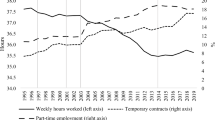Abstract
The behavior of time allocation to two types of discretionary activities is formulated as a doubly-censored Tobit model. The model is capable of incorporating cases where the entire amount of time available for discretionary activity is allocated to one type of activity and the other type of activity is not engaged at all. The model is applied to examine individuals' allocation of time to in-home and out-of-home discretionary activities on working days and non-working days, using a weekly time-use data set from the Netherlands. Workers' daily activity patterns vary significantly between working days and non-working days, while it can be expected that patterns of time allocation are correlated between working days and non-working days. A set of error components is introduced into the model to represent this correlation, adopting a mass point approach which requires no assumption about the distribution of the error components. The validity of the model is examined statistically.
Similar content being viewed by others
Reference
Abdel-Aty MA, Kitamura R & Jovanis PP (1995) Investigating the effect of travel time variability on route choice using repeated-measurement stated preference data. Transportation Research Record 1493: 39–45.
Ben-Akiva M & Lerman SR (1985) Discrete Choice Analysis. Cambridge: The MIT Press.
Davies RB & Pickles AR (1987) A joint trip timing store-type choice model for grocery shopping, including inventory effects and nonparametric control for omitted variables. Transportation Research A 21A: 345–361.
Dunn R, Reader S & Wrigley N (1987) A nonparametric approach to the incorporation of heterogeneity into repeated polytomous choice models of urban shopping behavior. Transportation Research A 21A(4/5): 327–343.
Heckman JJ & Willis R (1977) A beta-logistic model for the analysis of sequential labor force participation by married women. Journal of Political Economy 85: 27–58.
Jones PM, Dix MC, Clarke MI & Heggie IG (1983) Understanding Travel Behavior. England: Gower Publishing, Aldershot.
Kalfs N (1993) Hour by Hour: Effects of the Data Collection Mode in Time Use Research. Amsterdam: Nederlands Instituut voor Maastchappij-en Markt-Onderzoek.
Kitamura R (1988a) An evaluation of activity-based travel analysis. Transportation 15: 9–34.
Kitamura R (1988b) An analysis of weekly activity patterns and travel expenditure. In: Golledge RG & Timmermans H (eds) Behavioural Modelling in Geography and Planning (pp 399–423). London: Croom Helm.
Kitamura R & Bunch DS (1990) Heterogeneity and state dependence in household car ownership: A panel analysis using ordered-response probit models with error components. In: Koshi M (ed) Transportation and Traffic Theory (pp 477–496). New York: Elsevier Science Publishing.
Kitamura R, Robinson J, Golob TF, Bradley M & van der Hoorn T (1992) A comparative analysis of time use data in the Netherlands and California: Effects of commute times and store opening hours on travel and activity patterns. London: Proceedings of Seminar E, 20th PTRC Summer Annual Meeting, PTRC Education and Research Services Ltd., London, 127–138.
Kitamura R, Yamamoto T, Fujii S & Sampath S (1996) A discrete-continuous analysis of time allocation to two types of discretionary activities which accounts for unobserved heterogeneity. In: Lesort JB (ed) Transportation and Traffic Theory (pp 431–453). Oxford: Elsevier Science Publishing.
Laird N (1978) Nonparametric maximum likelihood estimation of a mixing distribution. Journal of the American Statistical Association 73: 805–811.
Lindsay BG (1983a) The geometry of mixture likelihoods: a general theory. Annals of Statistics 11: 86–94.
Lindsay BG (1983b) The geometry of mixture likelihoods, Part II: the exponential family. Annals of Statistics 11: 783–792.
Maddala GS (1983) Limited Dependent and Qualitative Variables in Econometrics. Cambridge: Cambridge University Press.
Nishii K, Kitamura R, Kondo K & Genma S (1995) Parameter estimation methods for repeated measurement data: Mass point model and mixing distribution model. Journal of Infrastructure Planning and Management 506/IV-26: 25–33 (in Japanese).
Pas EI (1988) Weekly travel-activity behavior. Transportation 15: 89–109.
Pas EI (1997). Recent advances in activity-based travel demand modeling. In: Texas Transportation Institute (ed) Activity-based Travel Forecasting Conference: Summary, Recommendations, and Compendium of Papers (pp 79–102). Washington, DC: Travel Model Improvement Program, US Department of Transportation.
Pas EI & Koppelman FS (1987) An examination of the determinants of day-to-day variability in individuals' urban travel behavior. Transportation 14: 3–20.
Pas EI & Sundar S (1995) Intrapersonal variability in daily urban travel behavior: some additional evidence. Transportation 22: 135–150.
Sugie Y, Zhang J & Fujiwara A (1996) Dynamic mode choice models considering unobserved heterogeneity based on mass point approach. Infrastructure Planning Review 13: 623–632 (in Japanese).
Tobin J (1958). Estimation of relationships for limited dependent variables. Econometrica 26: 24–36.
Uncles MD (1987) A beta-logistic model of mode choice: Goodness of fit and intertemporal dependence. Transportation Research B 21B(3): 195–205.
Author information
Authors and Affiliations
Rights and permissions
About this article
Cite this article
Yamamoto, T., Kitamura, R. An analysis of time allocation to in-home and out-of-home discretionary activities across working days and non- working days. Transportation 26, 231–250 (1999). https://doi.org/10.1023/A:1005167311075
Issue Date:
DOI: https://doi.org/10.1023/A:1005167311075




